Although public attention is focused on how to solve the problem of Social Security, the future financial problems of Medicare are twice as great.
- The unfunded liability (present value of obligations minus expected revenues) in Social Security over the next 75 years is about $4.3 trillion – a problem large enough to have captured the attention of the president, the Congress and the electorate.
- Yet the unfunded liability in Medicare over the same period is $8.9 trillion – greater than the country's entire current output of goods and services and more than twice the size of our national debt.
Like Social Security, Medicare faces the problem of a growing population of beneficiaries relative to taxpayers. The baby boom generation, which currently pays more than 60 percent of all taxes, will begin retiring in just 13 years. But Medicare's problems are made worse by two additional factors: rapidly expanding medical care technology and increased medical care utilization. If we continue on the present course:
- By the time today's college students reach retirement age, the tax burden created by Medicare will have grown from the current level of about 5.35 percent of payroll to almost 14 percent.
- In order for these students to collect their own benefits, future workers – most of whom are not yet born – will have to pay one out of every seven dollars they earn just to cover medical bills for the elderly.
And this is by no means the worst that can happen. If the Medicare trustees' pessimistic forecast proves correct, future tax burdens will be much greater.
Fortunately, there is a better way. Instead of a pay-as-you-go system under which each generation of retirees looks to the next generation to pay its medical bills, we can have a funded system under which each generation pays its own way. A funded program would work like this:
- Workers would deposit a portion of their Medicare tax dollars in Personal Retirement Insurance for Medical Expenses (PRIME) accounts to purchase their own health insurance and pay medical expenses directly during their retirement years.
- All individuals in the same age groups would make the same size deposit, and if individuals were unable to deposit enough because of low incomes, government would make up the difference.
- Sometime before their retirement, people would be required to use their PRIME account funds to purchase, at a minimum, catastrophic health insurance – choosing among competing private insurers much as seniors can choose among private health plans today.
- Funds not used for health insurance could be deposited in a Medical Savings Account (MSA) to pay small medical bills, items not covered by ordinary insurance and long-term care.
Although the future cost of the current Medicare system promises to be enormously burdensome, the cost of prefunding postretirement health care is quite manageable – if we reform the system now. For example:
- Under reasonable assumptions, young people entering the labor market today would need to deposit only about $600 a year – about half of what the average worker will pay in Medicare taxes, including Part B, under the current system.
- By age 65, these deposits will grow to more than $90,000 ($180,000 for a couple) in today's dollars – more than enough to purchase a private plan that duplicates Medicare's promised benefits.
- Even if medical expenses grow at a real rate of 2 percent, the required deposits to PRIME accounts will be less than the average worker would otherwise pay to Medicare even if the tax rate were to remain constant at today's rate.
Since the government must continue to fund benefits for current retirees, allowing those of working age to divert a portion of their Medicare taxes into PRIME accounts will cause an increase in the government deficit. However, this act will merely substitute explicit debt (outstanding government bonds) for the existing implicit debt (promises to pay future medical bills over and above expected tax revenues).
- Ignoring those on disability (about 13 percent of Medicare expenses) and assuming only moderate growth in spending, Medicare's unfunded liability is about $5.9 trillion.
- With the plan we propose, the unfunded liability would drop to $1.5 trillion or less.
Although the transition to a new system will be costly, failure to make the transition would be even more so.
[page]In their 1997 report, the Medicare trustees predicted that the Hospital Insurance Trust Fund (Medicare Part A) would be depleted by the year 2001. Since then Congress has taken a few steps to shore up the fund and postpone its depletion until 2008 – just 10 years away. However, Medicare's long-term prognosis remains bleak.1
"Medicare has an unfunded liability of $8.9 trillion."
Although the trust fund's imminent bankruptcy is getting all of the attention, the real story is the magnitude of the unfunded commitments we have made to future generations of retirees. The trust fund's bankruptcy is merely a symptom of Medicare's real financial problems. Under the current system, the growth in the tax base will not and cannot keep up with the projected growth in promised benefits. Using the Medicare trustees' most recent estimates, the total unfunded liability (the present value of expected benefits minus expected tax revenues) is $8.9 trillion. This huge unfunded liability has several causes. Primary among them is the rapid growth of the elderly population relative to the population of working taxpayers. This, of course, is the same problem faced by Social Security. But Medicare's problems are made worse by two additional factors: rapidly expanding medical technology and increased health care utilization.
With a liability of this magnitude, Americans face tough choices. Most of the proposals for solving the problem are aimed at stemming the growth in benefits while keeping the structure of the current system intact. These include increasing HMO enrollment, raising the retirement age and expanding retirees' choices of insurance plans. While these steps can go some of the way towards addressing Medicare's short-term financial crisis, they offer no permanent solution.
Real reform means replacing a pay-as-you-go system under which the elderly depend on younger taxpayers to pay their benefits with a system under which each generation pays its own way. This reform would allow people to set aside money in personal accounts during their working years from which to purchase health insurance and pay medical bills during the years of their retirement.
[page]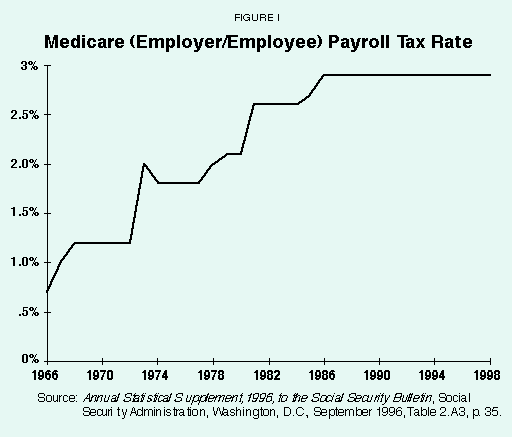
The bill establishing the Medicare program was signed into law on July 30, 1965, by President Lyndon B. Johnson. Medicaid, the program covering the health care costs of low-income families, was signed into law during the same year. Proponents of Medicare argued that it was needed because medical care costs were growing rapidly and retirees were caught unprepared and with insufficient income to cover these costs. Further, it was suggested that the market had failed to provide prepaid retirement medical insurance that individuals could purchase during their years in the labor force.
How Medicare Works. The original legislation created a two-part structure that has remained intact. Hospitalization Insurance (HI), or Medicare Part A, is financed by a 2.9 percent payroll tax, paid in equal parts by the employer and employee. Supplemental Medical Insurance (SMI), or Medicare Part B, is a voluntary program that pays for physician expenses and outpatient care. Monthly premiums paid by the elderly cover about 25 percent of the program's cost; the remaining 75 percent is funded by the government from general tax revenues.
"Unlike ordinary health insurance, Medicare has gaping holes in its coverage."
Unlike ordinary health insurance, however, Medicare has gaping holes in its coverage. A senior on Medicare can face thousands of dollars in out-of-pocket expenses. For example, according to the Health Care Financing Administration, 1.7 percent of seniors will spend more than $5,000 out of pocket on health care expenses.2 To avoid this possibility, about three-quarters of the elderly purchase (either directly or through their employers) medigap insurance – to pay deductibles, copayments and other expenses not covered by Medicare Part A or Part B.3 The result is a mixed blessing. On the one hand, most of the elderly are fully protected for Medicare-covered items.4 In fact, for these items they pay virtually nothing out of pocket. On the other hand, the first-dollar coverage afforded by private medigap insurance encourages elderly patients to spend more on medical care than they otherwise would. Indeed, one study estimates that medigap insurance increases total Medicare spending by 28 percent.5
Recent Medicare Reforms. Almost all health economists and health insurance industry analysts believe that the tripartite structure of elderly health insurance – Medicare Part A, Medicare Part B and medigap – is inefficient and contributes to rising health care costs. Thus Blue Cross or some other insurer should be able to replace the three insurance plans with a single plan that provides reasonable coverage at a lower cost. To exploit this opportunity, most senior citizens for several years have been able to opt out of Medicare and join a private HMO, and about 13 percent are currently doing so. Beginning next year the elderly will have even more alternatives – ranging from HMOs to Medical Savings Account plans.
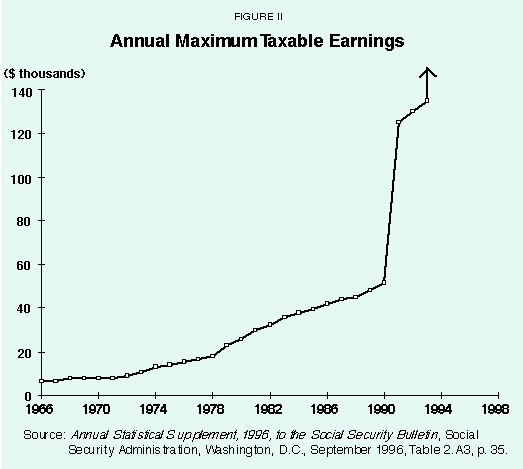
There is considerable debate about what impact these reforms will have. On the one hand, the 1998 trustees report estimates that their enactment, along with other reforms, will reduce Medicare's long-term actuarial deficit by one-half. On the other hand, studies show that the contracting out that has occurred so far has increased, not reduced, overall Medicare spending.6
"Medicare expenditures have increased 1,040 percent since the program's inception."
Rising Costs. Since its inception, Medicare has been primarily financed by taxing workers to pay benefits for retirees. In essence, one generation is paying for another generation's health care. Under this approach, to keep tax rates from rising benefits must grow no faster than the growth in the tax base. This kind of financing seemed feasible in 1965. At that time, there were only 17 million retirees, real wages were rapidly rising and more than 77 million future workers were less than 19 years of age. Two subsequent events have conspired against the rosy outlook that prevailed at the system's beginning. First, the growth in Medicare spending has consistently exceeded the growth in the tax base.7 Second, the baby boomers who made pay-as-you-go financing look good in 1965 make this kind of financing look bad today as they approach retirement age.
- From 1967 to 1997, the number of Medicare enrollees almost doubled, from 19.5 million to 38 million.
- Over the same period, average Part A expenses per retiree grew 481 percent (or 5.37 percent per year) in real terms, and per-retiree Part B expenses grew 641 percent (or 6.39 percent per year).
- The combination of the growth in the retired population and the growth in real per capita Parts A and B expenditures has resulted in an increase in all Medicare expenditures of 1,040 percent since the program's inception.
"The level of earnings subject to the payroll tax has risen from $6,600 to the current unlimited level."
Overall, real Medicare expenditures have grown at an annual rate that is three times higher than the growth rate of real wages (8.12 percent versus 2.22 percent). As a result, the Medicare payroll tax has been increased several times, starting at 0.7 percent in 1966 and reaching its current level of 2.9 percent in 1986. [See Figure I.] Besides the growth in the tax rate, the level of earnings subject to the tax rose from $6,600 in 1966 to the current unlimited level in 1994. [See Figure II.] In spite of these efforts to increase Medicare tax revenues, the system currently pays out more in benefits than it receives.
Avoiding Fundamental Reform. The two-part structure and the multiple funding sources have allowed Congress to tinker with the system without making lasting reforms. For example, the shifting of home health care costs from Part A to Part B in the Balanced Budget Act of 1997 helped to postpone the bankruptcy of the Part A trust fund until 2008, thereby hiding some of Medicare's financial problems. Even with those accounting changes, the bankruptcy still comes three years before the first baby boomer begins to draw benefits.
[page]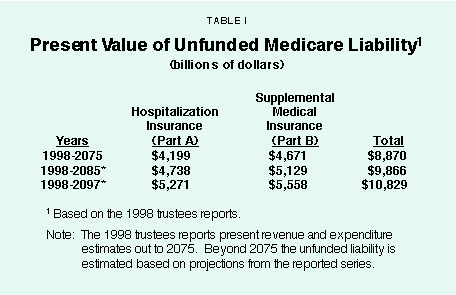
Baby boomers are currently at their peak earning power and therefore at their peak tax-paying capacity. As a group they contribute more than 60 percent of all federal tax revenues. As they retire, they will be replaced by a much smaller generation whose tax rates will have to be far higher. And because baby boomers will then be net consumers of federal revenues rather than net contributors, the tax burden on the smaller generation will be even larger.
Medicare's Unfunded Liability. To appreciate the magnitude of this problem, consider Medicare's unfunded liability (present value of expected future spending minus expected future revenues).8 As Table I shows:
- Medicare's future expenses exceed its projected income by $8.9 trillion over the next 75 years.
- This unfunded liability is more that two times the size of the total federal debt currently held by the public ($3.8 trillion).
- Medicare's liability also is more than twice the size of Social Security's unfunded liability. [See Figure III.]
"Medicare's future expenses exceed its projected income by $8.9 trillion over the next 75 years."
Although the need to reform Social Security has been far more visible in public policy discussions, Medicare clearly has the more serious financial problem. If they are not addressed, both elderly entitlements will consume an increasing portion of the nation's output.
Generational Accounting. Medicare's commitments can also be measured using the generational accounting techniques developed by Alan Auerbach, Jagadeesh Gokhale and Laurence Kotlikoff.9 Generational accounting identifies the net tax payments – that is, lifetime taxes paid less lifetime benefits received – for each existing age group and for future generations. Ideally, at birth each new generation should expect to receive benefits equal to the taxes it will pay. Under the current system, however, current newborns will pay federal taxes far in excess of any expected federal benefits. Indeed, Gokhale and Kotlikoff estimate that in order to make Medicare benefits equal to lifetime taxes for newborns and future generations, Medicare benefits would have to be cut 68 percent beginning in 1998. If reform is postponed until 2003, benefits would have to be permanently cut by 78 percent. If the program were not reformed until 2016, just five years into the retirement of the oldest group of baby boomers, even its complete elimination would not produce generational balance!10
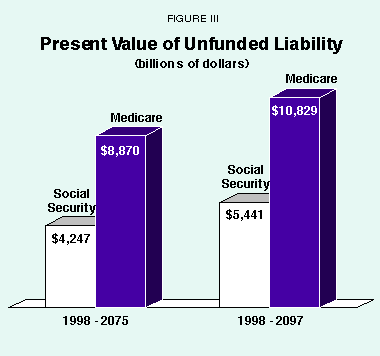
"A child born today will pay federal taxes far in excess of any expected federal benefits."
Actuarial Imbalance. A third way to look at the problem is to analyze the Medicare trust funds the way actuaries would analyze a private pension fund. Proceeding in this way, the Medicare trustees estimate that to balance the books for the next 25 years, the Part A tax rate would have to be increased immediately from the current 2.9 percent to 3.62 percent. To bring about actuarial balance over the next 75 years, the tax rate would have to be increased immediately to 5 percent.11
The problem with this approach is that it ignores the pay-as-you-go nature of Medicare financing. Medicare payroll tax revenues are spent almost as quickly as they are collected. They are mainly spent on elderly health care. But if Medicare tax revenues (inflow) exceed Medicare spending (outflow) the difference is accounted for by depositing special, interest-bearing government bonds into the Medicare (Part A) trust. From an accountant's point of view, these bonds are an asset; and if the payroll tax rate were higher, the trust fund would accumulate more such assets. However, every increase in the assets of the Medicare trust fund increases the liabilities of the U.S. Treasury. Summing over both parts of government, they net out to zero. Put another way, the trust funds consist of IOUs the government has written to itself. Regardless of the state of the trust funds, in order to pay more benefits in the future the government will have to tax or borrow.
Projected Future Taxes. A fourth way of looking at the problem is to focus on the tax revenues that will have to be collected in future years to pay promised benefits. According to the most recent trustees' report, Part A spending as a percent of payroll will climb to 4.62 percent in 2020 and 6.72 percent in 2040. If Part B spending is expressed as a percent of payroll, the implied total Medicare tax would be 9.78 percent and 13.63 percent in 2020 and 2040, respectively. [See Figure IV.]
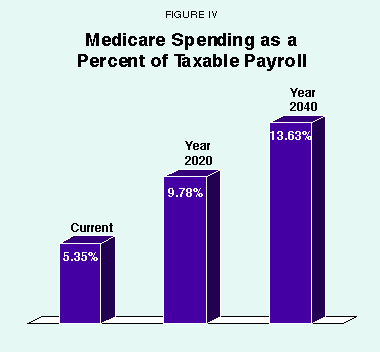
Need for Change. Because the crisis we are discussing will become more evident in the future, many people think that Medicare's financial problems will occur only when the trust fund is exhausted or when the baby boomers retire. But the crisis is here and is best dealt with today. What the present value calculations, the generational accounting estimates and the trustees' projected tax rate increases all show is that waiting to secure Medicare's financial position is courting disaster.
[page]"An alternative to the pay-asyou-go approach is a system under which each generation pays its own way."
An alternative to Medicare's current pay-as-you-go approach is a system under which each generation prefunds its retirement health care expenditures and pays its own way. Prefunding Medicare could be accomplished by requiring each age cohort (all individuals born between January 1 and December 31 in any given year) to pool together, making deposits to private savings accounts and eventually paying premiums that would insure against postretirement medical expenses. What follows is a brief description of how the reform would work. [See Saving Medicare: A Ten-Point Plan.]
Private Savings (PRIME) Accounts. Each individual would be required to make annual deposits to a Personal Retirement Insurance for Medical Expenses (PRIME) account. These private savings accounts would grow until retirement and would accumulate sufficient funds to allow the purchase of basic health insurance during the years of retirement. The same dollar contribution to PRIME accounts would be made by all members of the same age group, and the required amount would be adjusted from year to year to insure sufficient funds for postretirement health care.12 For example:
- To replace Medicare, a 25-year-old would need to deposit about $668 a year, every year, until retirement – an amount equal to about 2.4 percent of the average person's wage over the next 40 years.
- A 35-year-old would have to contribute about $1,098 – a larger amount since he or she has only 30 years over which to accumulate the necessary funds.
- A 45-year-old would need to contribute about $2,008 each year for the next 20 years.
These deposits would be funded by dollar-for-dollar reductions in the workers' payroll tax liability. Roughly speaking, workers would put money aside in their own accounts rather than paying taxes to Medicare. A more complete discussion of the required contribution amounts and the assumptions behind them is provided below.
"Each individual would be required to make annual deposits to a Personal Retirement Insurance for Medical Expenses (PRIME) account."
Since participation in Medicare is compulsory, participation in any private-sector alternative also would be compulsory. Whether or not compulsion is justified, it solves two important problems. First, mandatory participation eliminates a potential "free rider" problem. As a society, we have decided that individual access to health care will not depend on ability to pay. Yet knowing that society will take care of them, individuals have an incentive to save less than they may need to fund their retirement medical care expenses. Mandatory participation also addresses the adverse selection problem that would result if individuals could opt into the system only when they expected to incur large medical expenses.
Accounts for Low-Income Workers. Those whose deposits fall short of the required amount because of low earnings would have their accounts topped up by the government. The required contributions of those who earn more than enough to fund their accounts would support the topping up. Taken as a whole, as each age group reaches retirement age there would be enough money to cover their retirement health care insurance premiums.
Accounts for Spouses. Married workers also would have to divert a portion of their Medicare payroll taxes to the PRIME accounts of nonworking spouses. These deposits would be accounted for separately so the nonworking spouses would be fully protected in cases of death, separation or divorce.
Investment of PRIME Accounts. Individuals would select a manager for their PRIME account from among competing financial institutions, which would be required to invest PRIME funds prudently and conservatively in a diversified portfolio.
"Those whose deposits fall short because of low earnings would have their accounts topped up by the government."
Postretirement Health Insurance. Sometime before their 65th birthday, individuals would have to use their PRIME account funds to purchase postretirement private health insurance. Such insurance could consist of an HMO, PPO, MSA or some other plan, but the chosen plan would include catastrophic coverage for basic medical care. The proposed insurance would be similar to today's Medicare in that it would pay no death benefit. Funds not used for third-party insurance could be placed in a Medical Savings Account to purchase medical care directly or to pay for long-term care.
Death Benefit. Unused MSA balances and other PRIME account funds not used to purchase catastrophic insurance could be transferred to an individual's heirs at death.
Medicare Buy-In Option. As an alternative to private insurance, individuals could use their PRIME account funds to buy back into Medicare during the transition period.
Funding the Transition. Throughout the transition period, Medicare taxes would be kept at their current level. Tax revenue not diverted to PRIME accounts would fund Medicare benefits for those already retired or near retirement and retire any debt incurred as a result of the transition.
The medical care risks of current and future retirees will exist regardless of who acts as the insurer. What medical care will encompass and what proportion of total resources will be dedicated to it in the future is unknown. Yet it does not follow that the government must be the insurer or that transfer payments must fund retirement medical expenses. The real question is whether future retirees will pay for their own retirement medical purchases or rely on their children and grandchildren to pay. Pay-as-you-go financing shifts the risks from medical care consumers to taxpayers. Prefunding links the consumers of medical care to its funding.
[page]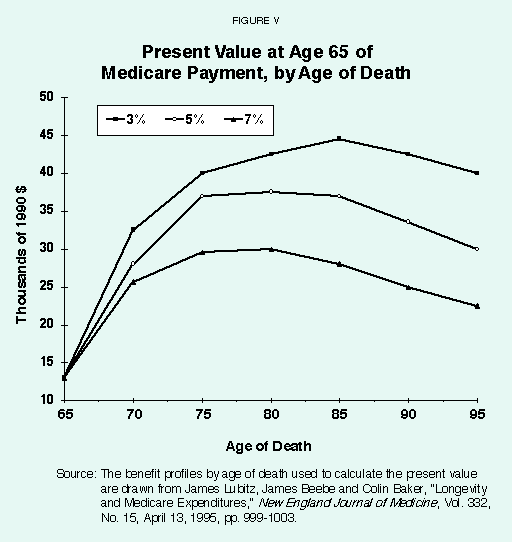
The prefunding of care will insure that future taxpayers are not responsible for the medical care expenses of retirees. As each age group retires, enough funds will have been accumulated to cover that group's total insured expenditures. Given that we have potentially solved the funding problem, however, a host of other questions remain. What type of health insurance should people be permitted (required) to buy? When should they be permitted to buy it? What premium should insurers be able to charge? What should be the duration of the insurance contract? How frequently should people be able to switch health plans?
These questions do not uniquely stem from the reform plan we are proposing. The same questions must be addressed under the current structure of Medicare. And the answers imbedded in the current system are not necessarily the best answers.
"At retirement, people could choose among competing health plans."
Health Insurance Options. Until recently, all beneficiaries under Medicare had essentially the same insurance coverage. For reasons discussed above, the design of Medicare is quite inefficient and private insurers surely could improve on it. The first ones given the opportunity to create an alternative were certain Health Maintenance Organizations (HMOs). Most seniors now have the option to join an HMO with most or all of the premium paid by Medicare and about 13 percent have done so. Beginning in 1999 seniors will have other options, including private fee-for-service plans, Medical Savings Account (MSA) plans and physician-run plans.
Since choices of this sort are already planned under the current Medicare system, it seems almost inevitable that they would also be a feature of any private, prefunded alternative. Choice has obvious potential benefits for the insured, giving them opportunities to select the most suitable plans. Encouraging insurers to find innovative new ways to meet consumer demand also can have benefits. But competition in health insurance can have drawbacks as well, especially when premiums are artificially constrained.
For example, under the current system HMOs receive the same Medicare payment, regardless of the expected health care costs of the enrollee, with some exceptions discussed below. This gives the HMOs a perverse incentive to avoid the sick, whose expected costs exceed the premium income they generate, and attract the healthy, whose premiums exceed their expected costs. Moreover, if people develop a health problem after they enroll, HMOs have an incentive to provide less than optimal care in an effort to encourage them to switch back to Medicare or to some other HMO. Whatever their resolutions, these problems must be confronted regardless of how Medicare is financed.
Timing Options. Given that people will be able to use their PRIME account funds to obtain insurance, at what age should they be able to exercise that option? Must they wait until they are 65? Or should they be able to select an insurer much earlier? (Note: even under the current system, people could be allowed to select a private insurer long before they reach age 65.)
"One question to be resolved: at what age should an insurer be selected?"
Either approach has advantages and disadvantages. The main problem with early commitment is that neither the insured nor the insurer has important information that will be revealed years after the choice is made. On the consumer side, someone entering the labor market today at age 22 will not know how the health plans are going to function 43 years later – when the chooser will actually need the services. On the supplier side, insurers may be unwilling to commit so many years in advance. If they do commit, they may be unwilling to promise the same benefits that they would at a later date. The reasons are obvious: uncertainty over the cost of medical care and uncertainty over the performance of capital markets.
Early choice would help solve the problem of varying health care risks, however. For example, if people choose their insurer in the prefunded system at age 22, when they presumably know little about what their medical care needs will be at age 65 and beyond, then each insurance pool will tend to have a cross-section of individuals – some of whom will be sick and some of whom will be healthy by the time they all reach age 65. On the other hand, if individuals choose their insurer at age 65, when they know more about their medical care risks, problems of adverse selection are likely to arise.
The problems that arise if health plans are required to accept all applicants are addressed above. And if they can reject applicants with high expected health costs, different problems arise. In any health insurance pool, the lower risks in the group are subsidizing the higher risks. This creates an incentive for lower risks to move to another pool with lower average risks and lower premiums – an option not available to high-risk members. As the low risks leave, premiums must be increased to cover the now-higher costs of the remaining members. Higher premiums, in turn, encourage even more departures. The result is a "death spiral" in which the plan is left with only the most expensive enrollees – who cannot afford to pay premiums that cover the cost of their care.
Pricing Options. One way to avoid the death spiral described above is to allow insurers to charge premiums that reflect expected costs for everyone who joins the pool. Thus, sick people would be charged higher premiums and healthy people lower ones. Under the current system, HMOs are not allowed to charge different out-of-pocket premiums to enrollees, based on their health status. However, Medicare's payment to the HMOs does vary depending upon certain indicators of expected costs, and more such risk adjustment of premiums is expected in the future.13 A similar kind of risk adjustment could be forced on the private system envisioned here by requiring pools that disproportionately attract healthy people to make payments to pools that disproportionately attract sicker people.
"Many problems would disappear if people had to choose a plan and remain in it for at least three or four years."
Still, no risk adjustment scheme works very well. Based on objective factors alone, health economists can predict no better than about 25 percent of the variation in future health care costs among individuals.14 Part of the problem is that information is often asymmetric. Enrollees have knowledge about their own health neither insurers nor risk adjusters possess. Perversely, insurers can sometimes take advantage of this asymmetry by making their health plans less attractive to sick people and more attractive to healthy people. The more freedom the plans have to differentiate their product, the more opportunities they have to encourage the healthy and discourage the sick.
Thus pricing restrictions exacerbate the trade-off described above: the more choices people have, the greater the problems of adverse selection. One way out of this problem may be to require lengthier insurance contracts.
Length of the Contract Options. How long should anyone be required to stay in his or her chosen health plan before switching to another? Most employers who give employees choices tend to allow switching only once a year. Although the new Medicare program will permit switching at will initially (except for the Medicare MSAs), eventually it also will revert to an annual enrollment. But is a one-year contract the best option? An alternative would be to require people to choose a health plan at age 65 and remain in that plan for the rest of their lives. A long-term insurance contract would reduce the problem of adverse selection in several ways. For the reasons given above, the longer the time horizon, the less information anyone has about future health care costs, and people who are sick today are not necessarily the most expensive patients over the long haul, since people who die soon do not generate more costs 10 or 20 years down the road.
Thus under long-term contracts insurers face both health care risks and longevity risks. Figure V shows the present value of annual Medicare payments (as of age 65) for individuals who die at different ages, using three discount rates: 3 percent, 5 percent and 7 percent. As the figure shows, individuals who die between ages 65 and 70 have lower health care costs than those who die later.
The conclusion is that many problems associated with annual movement among plans would disappear if people had to choose a plan and remain in it for at least three or four years.
[page]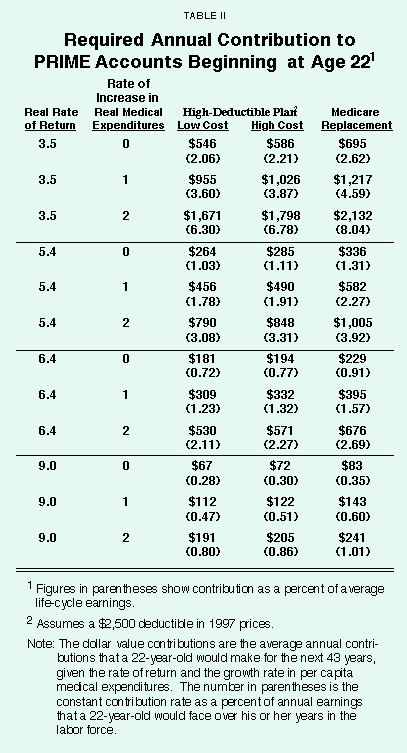
"Individuals who die between ages 65 and 70 have lower health care costs than those who die later."
15How large would the deposits have to be in order for each new cohort to fund its postretirement health care expenses? Table II shows the required contributions, expressed as an annual deposit and as a percent of life-cycle earnings income, that an average new labor force entrant would face until age 65. The required contribution varies with assumptions about the rate of return on investments, the growth rate in medical expenditures and the cost of the prefunded benefits.16 Let's consider each of these assumptions in turn.
Rate of Return for PRIME Accounts. Provided that PRIME account funds were invested professionally and conservatively in a diversified portfolio, what rate of return would we expect? Poterba and Samwick calculated that for the years 1947 through 1995 the nonfinancial corporate sector paid a real pretax rate of return of 9.2 percent.17 Feldstein and Samwick estimate that a portfolio of 60 percent equity and 40 percent debt would have yielded a real pretax return of about 5.5 percent over both the postwar period and the period since 1926.18 They also suggest that if corporate taxes at all levels take 40 percent of pretax debt and equity income, a 5.4 percent after (corporate) tax return is equivalent to a 9 percent pretax return.
In making the calculations in Table II, we estimated the amount of annual deposit required based on four different rate of return assumptions: a conservative 3.5 percent rate, the after-tax 5.4 percent rate and the pretax 9 percent rate for a balanced portfolio, plus a 6.4 percent rate for a 100 percent equity portfolio – reflecting the real rate of return between 1926 and 1995 based on the Standard & Poor's 500 Index including dividend reinvestment.
"Under reasonable assumptions, young people entering the labor market today would need to deposit about $500 a year."
Rate of Growth of Health Care Costs. Because the actual growth in retirement health care expenditures is unknown, we estimate the required deposit using three different assumptions about the real growth rate of per capita medical care expenditures: 0, 1, and 2 percent. By way of comparison, the Medicare trustees in 1997 assumed that Medicare's real cost per unit of service will grow at a rate of about 3 percent during the first 10 years of the forecast, gradually decline to about 1.7 percent by the 25th year and drop to a growth rate equal to the growth rate in real wages in all remaining years.
Cost of Health Insurance at Today's Prices. The table also presents estimates of the required deposit based on estimates of the cost of postretirement health insurance at today's prices, assuming that people choose the current Medicare package, a high-deductible ($2,500) package under low-cost assumptions or a high-deductible package under high-cost assumptions.19
Results. The contribution rate for entering cohorts ranges from a low of $67 per year to a high of $2,132, based on the differing cost and growth rate assumptions. Under a reasonable investment strategy, the required contribution is well below Medicare's total expenditures on health care for the elderly (net of premium payments), which equaled 4.39 percent of taxable payroll in 1996. Thus if government continues to impose the 4.39 percent tax, it is possible for new entrants to fund their retirement medical care, with some of the tax money left over to fund the cost of the transition. For example, as Figure VI shows:
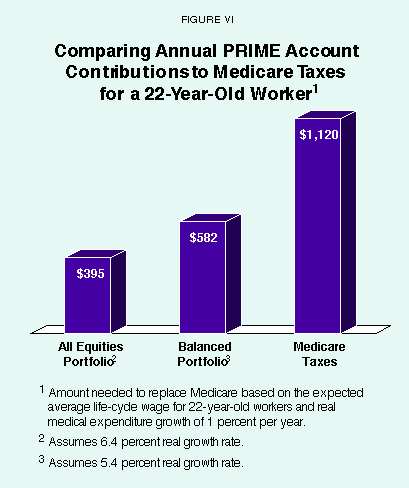
- Assuming 1 percent real growth in medical expenditures, a worker whose PRIME account funds were invested in equities could replace Medicare for an annual contribution of only $395.
- A worker whose funds were invested in a balanced portfolio could replace Medicare for an annual contribution of $582.
- These amounts are well below the $1,120 tax that Medicare is expected to collect from the average worker over the same time period.
One way to think about these results is to consider that private pension funds often invest in equities for most of a worker's career and then shift to bonds in the last 10 or so years to protect against market fluctuations on the eve of the individual's retirement. Following that strategy, under these assumptions, a worker would have to deposit about $500 – less than half the expected Medicare tax.
Even if medical expenditures grow at the faster rate of 2 percent per year in real terms, the private option is more attractive for workers. The required deposit, which ranges between $676 and $1,005 depending on the investment strategy, is still less than Medicare is expected to extract under the current system.
Figure VII shows how the deposits will grow over time if invested in a balanced portfolio. As the figure shows, an annual investment of $582 will grow to more than $90,000 in 1997 prices – and more than $180,000 for a married couple – by age 65. This should be sufficient to replace Medicare with comparable private health insurance. As an alternative, people may prefer high-deductible, catastrophic insurance – managing their own health care dollars for smaller expenses. As Figure VII shows, an individual who saved for Medicare replacement would accumulate as much as $20,000 – $40,000 for a couple – to place in a Medical Savings Account to pay medical bills under $2,500 a year, long-term care expenses and other items not covered by Medicare.
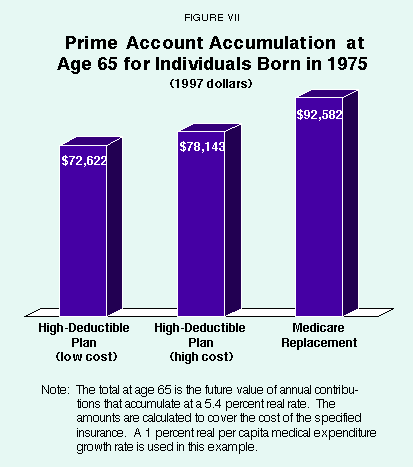
"Older workers would make larger contributions."
Figure VIII shows how the required contribution to PRIME accounts varies for people of different ages at the time the plan is instituted. As the figure shows, older workers would make larger contributions. Still, under reasonable assumptions a worker earning the average wage could prefund his or her postretirement health care with PRIME account contributions less than expected Medicare taxes out to about age 40.
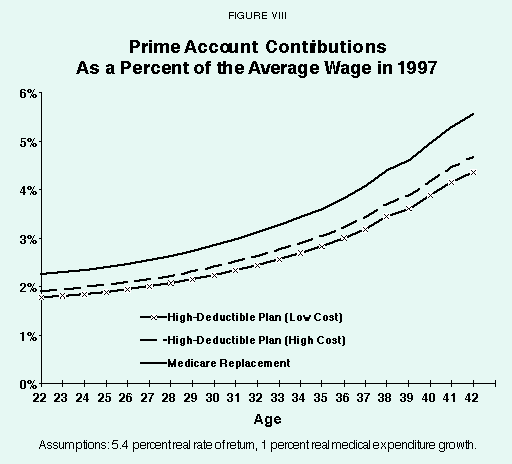

During the transition to a private, prefunded postretirement health care system, the commitments to the currently retired population and those close to the retirement age must be kept. At the same time, workers' contributions to PRIME accounts in lieu of Social Security taxes will increase the size of the federal deficit. The following simulations evaluate the transition costs, assuming a real rate of return of 5.4 percent and real per capita medical expenditures growth of 1 percent.
Transition Plan. Transition to the new system would be structured in the following way. All baby boomers would be shifted to the new system, so everyone born in 1946 and later would be in the new system. Everyone older than 51 in 1997 would remain in the old system. Thus Medicare would continue to fund benefits as it currently does for each new cohort that would reach age 65 through the year 2010. After 2010 no new beneficiaries would be added to the old system. As a result, Medicare spending after 2010 would continuously decline and approach zero by 2046. The current Medicare tax of 4.39 percent would remain in effect throughout.
"During the transition, the commitments to those currently retired and near retirement must be kept."
Each cohort would contribute to their PRIME accounts based on an estimate of what would be needed to fund their postretirement health care. As Table II shows, new labor force entrants contribute an amount equal to between 1.78 percent and 2.27 percent of their average wage income, assuming a real rate of return of 5.4 percent and per capita medical expenditure growth of 1 percent. Older workers would make larger contributions. Those ages 38 to 42 would contribute an amount equal to the entire Medicare tax for the average worker, while those between 43 and 51 would contribute more than the current average-wage Medicare tax. For these age groups, the extra contributions are incorporated into the following estimates of the transition cost.
Cost of the Transition. Since workers will be able to divert part of the taxes they now pay to fund Medicare benefits to current retirees, the cost of the transition will be the funds needed to replace this revenue loss. If the federal government funded this revenue gap by borrowing, that would increase the size of the federal debt. However, as the baby boom generation dies off Medicare expenses decline. Eventually, the Medicare tax collected will be more than sufficient to pay benefits and this surplus can be used to retire the debt.
Given that younger workers will be able to prefund their retirement insurance, under reasonable assumptions, by contributing less than their current Medicare taxes, part of the transition cost can be offset by the difference between the Medicare tax rate and the PRIME account contribution rate.20 Thus throughout the entire transition period, the difference between the Medicare tax of 4.39 percent and the contributions to PRIME accounts will provide transition funding. For example, if new entrants to the labor market are required to contribute 1.78 percent of the average wage to their PRIME accounts, then 2.61 percent (4.39 – 1.78) of their earnings will be available to fund the transition.
Effects on Medicare's Unfunded Liability. As Figure IX shows, a transition to a funded system is less costly than maintaining the status quo. The present values are calculated using a 2.7 percent real rate of return, the rate used by Medicare's trustees in their 1997 report, and the revenue and liability series are extended out to the year 2080. As the figure shows, the status quo unfunded liability is $5.9 trillion. This number is less than the one presented in Table I for two reasons. First, the 1 percent growth rate in health care expenditures is less than the growth rate assumptions used by the actuaries. Second, the status quo liability presented in Figure IX reflects the liability associated with Medicare for the aged population only, not including the Medicare costs of the disabled (about 13 percent of the total costs). Under all reform scenarios, the present value of the systemwide unfunded liability is much lower. If PRIME accounts are used to prefund (low-cost) high-deductible insurance, the present value of the transition liability is $398 billion. With (high-cost) high-deductible insurance, the transition liability is $712 billion. The cost of prefunding Medicare's current benefits is $1.5 trillion.
Funding the Transition. The additional cost of the three transition scenarios could be covered by a tax increase of .22, .40, and .86 percent, respectively. These compare to the tax increase of 3.39 percent that we calculate would be needed to maintain the status quo under the same assumptions.
[page]"In 10 years, Medicare as we now know it will not exist."
In 10 years, Medicare as we now know it will not exist. The system's huge unfunded liability and generational imbalance will force significant changes. How society will pay for future retirement health care and how much is actually expended on this care need to be seriously and soberly addressed. Making a bold move today to a prefunded system will give individuals ownership in their retirement medical insurance, link the consumers to the amount of care they purchase and bring market forces – largely absent in the current system – to the delivery of medical care to the aged.
NOTE: Nothing written here should be construed as necessarily reflecting the views of the National Center for Policy Analysis or as an attempt to aid or hinder the passage of any bill before Congress.
[page]Hospital Insurance
Because the Hospital Insurance (HI) portion of Medicare is funded by a payroll tax, the difference between the expected HI expenses and expected HI tax revenues is the basis for the present value calculations. The yearly estimates come from the Table III.B4, "Estimated OASDI and HI Income Excluding Interest, Outgo, and Balance in Current Dollars by Alternative, Calendar Years 19972075, Intermediate Estimates," in the 1998 OASDI Trustees Report. The values are in nominal dollars and are brought to the present using the nominal discount rate assumptions reported in Table II.D1, "Selected Economic Assumptions by Alternative, Calendar Years 1960-2075" in the 1998 OASDI Trustees Report.
Calculating the Unfunded Liability Based on the 1998 Trustees Reports: Supplementary Medical Insurance
Supplementary Medical Insurance (SMI) is financed by beneficiaries' premiums, set permanently at 25 percent of the program's expenditures by the Balanced Budget Act of 1997, and by general revenues. As the trustees put it, "The SMI premium and the corresponding income from general revenues are established annually at a level sufficient to cover the following year's expenditures. Thus, the SMI program is automatically in financial balance under present law, in contrast to OASDI and HI, where the financing established years earlier may prove significantly higher or lower than subsequent actual costs" (1998 Annual Report of the Board of Trustees of the Federal Supplementary Medical Insurance Trust Fund, p. 9). With this sort of financing the SMI program will technically never have an unfunded liability.
However, if we fix two things at the beginning, the premium as a percent of total expenditures and the funding following the same path as HI's funding, then we can estimate the unfunded liability in a manner similar to the way we calculated the HI unfunded liability. We fix the premium in all future periods at 25 percent of projected expenditures. The projected expenditures out to 2007 are from Table I.E1 (p.10) in the 1998 SMI Trustees Report. For the years beyond 2007, we use the projected SMI disbursements as a percent of GDP that are reported in Table III.A1 (p.65) in the 1998 SMI Trustees Report and multiply by projected GDP, which is reported in Table III. C1 in the 1998 OASDI Trustees Report. In addition to the premium, which is set at 25 percent of expenditures, we project implied tax revenues in the following way. In 1998 implied tax revenues are set equal to SMI expenditures less the 25 percent premium payment. Thus expenditures less revenues in 1998 are equal to zero in 1998. For all future years, the implied tax revenues grow at the exact rate at which HI tax revenues are expected to grow. Like the HI calculations, the difference between the two revenue and expenditures series is brought to the present using a nominal discount rate assumption reported in Table II.D1 in the 1998 OASDI Trustees Report.
[page]- 1998 Annual Report of the Board of Trustees of the Federal Hospital Insurance Trust Fund, Washington, D.C., April 1998; 1998 Annual Report of the Board of Trustees of the Federal Supplementary Medical Insurance Trust Fund, Washington, D.C., April 1998; and 1998 Annual Report of the Board of Trustees of the Federal Old-Age and Survivors Insurance and Disability Insurance Trust Funds, Washington, D.C., April 1998.
- Health Care Financing Review: Medicare and Medicaid Statistical Supplement, 1995, HCFA Pub. No. 03374, September 1995.
- PPRC Annual Report to Congress, 1996, Physician Payment Review Commission, p. 282. Estimate is for 1992.
- Two notable items not generally covered are prescription drugs and long-term care.
- PPRC Annual Report to Congress, 1996, p. 291.
- For an analysis see Bernice Steinhardt, "Medicare: Fewer and Lower-Cost Beneficiaries with Chronic Conditions Enroll in HMOs," General Accounting Office, Washington, D.C., August 18, 1997.
- For example, an actuarial study of Medicare Part A legislation estimated it would cost $900 million in its first year and $1.7 billion by the tenth year. Actually, the Medicare hospitalization program cost $2.7 billion and $10.9 billion, respectively. See Donald Quinlan, "The Assumptions Behind Political Medicine are False: A Study of the Truth," Testimony delivered before the Health Subcommittee, House Ways and Means Committee, September 12, 1975, pp. 7-8.
- To create these estimates we take the projected expenditure stream and subtract from it the projected tax revenues. For the Hospitalization Insurance portion, this is a fairly straightforward calculation using the numbers reported by the Medicare trustees. To estimate the SMI unfunded liability, we assume that beneficiaries will continue to pay 25 percent of the projected expenditures, which grow at the same rate as the dedicated HI costs. Present values were calculated using the nominal discount rate implied by the trustees' intermediate assumptions. (See the Appendix for more detail.)
- Alan Auerbach, Jagadeesh Gokhale and Laurence J. Kotlikoff, "Generational Accounts: A Meaningful Alternative to Deficit Accounting," in D. Bradford, ed., Tax Policy and the Economy 5 (Cambridge Mass.: MIT Press, 1991), pp. 55-110.
- Auerbach, Gokhale and Kotlikoff.
- In last year's report a tax increase of 69 percent was required for actuarial balance for the next 25 years and a 150 percent increase for actuarial balance for the 75-year horizon. The improvement between the two years lies in limiting payment increases to providers, moving toward prospective payments and away from reimbursements and shifting home health care costs to Part B.
- The real rate of return used here is 5.4 percent and the medical expenditures per capita grow at a real rate of 1 percent.
- Risk adjustment is the process whereby a government entity reimburses an insurer a larger portion of funds for people with medical conditions.
- See Joseph P. Newhouse, Melinda Beeuwkes Buntin and John D. Chapman, "Risk Adjustment and Medicare: Taking a Closer Look," Health Affairs, vol. 16, no. 5, Sept/Oct 1997, pp. 26-43.
- This section is based partly on Phil Gramm, Andrew J. Rettenmaier and Thomas R. Saving, "Medicare Policy for Future Generations – A Search for a Permanent Solution," New England Journal of Medicine, vol. 338, no. 18, April 30, 1998, pp. 1307-10.
- For more detail on estimating each component in the forecasts, see Andrew J. Rettenmaier and Thomas R. Saving, "Medicare Reform: A Cohort Based Solution," Private Enterprise Research Center, Working Paper no. 9804, December 1997. In particular, we forecast future earnings growth by sex, age and education, based on historical rates, and therefore we do not vary a single earnings growth rate parameter in our projections as is done in the Trustees Reports.
- James M. Poterba and Andrew Samwick, "Stock Ownership Pattern, Stock Market Fluctuations, and Consumption," Brookings Papers on Economic Activity, 1995:2, pp. 295-357.
- Martin Feldstein and Andrew Samwick, "The Economics of Prefunding Social Security and Medicare Benefits," NBER Working Paper 6055, 1997.
- These costs are estimated from the 1994 Annual Person Summary (APS) Medicare reimbursement data. These data are used in preparing some of the tables in the Annual Statistical Supplement to the Health Care Financing Review. Here the data are used to impute the claims distribution by age. For the low- and intermediate-cost calculations, the claims distribution is adjusted downward to reflect the effects of a higher deductible on expenditures. The effects of the higher deductible are drawn from the RAND Health Insurance Experiment results. See Emmett B. Keeler, Joan L. Buchanan, John E. Rolph, Janet M. Hanley and David M. Reboussin, "The Demand for Episodes of Medical Treatment in the Health Insurance Experiment," RAND Corporation, March 1988. Because Medicare's two-part structure is not directly comparable to any of the insurance instruments simulated in the RAND report, the low-cost and intermediate-cost estimates are presented to show the bounds of the effects of a higher deductible on medical care utilization. The current Medicare package is the average age-adjusted reimbursement based on the APS data. For more detail on how the Annual Person Summary data were used to estimate the cost of the higher-deductible policy, see Rettenmaier and Saving, "Medicare Reform: A Cohort Based Solution."
- Since individuals up to the age of 42 can fund their own retirement medical insurance for less than 4.39 percent of their remaining life time earnings, they are contributing toward the retirement health insurance of those in the old system and those over 42 in the new system. Thus, a full 2.61 percent of the earnings of all new entrants to the labor force during the transition is available to defray the transition cost. In addition, contributions to the cohort-based insurance for individuals ages 43 to 51, which are in excess of the 4.39 percent implied tax, are counted against the transition tax revenues; but all of the tax revenues collected from those 52 and above would be counted as transition tax revenues.
Dr. Thomas R. Saving is the Director of the Private Enterprise Research Center at Texas A&M University. A University Distinguished Professor of Economics at Texas A&M, he also holds the Jeff Montgomery Professorship in Economics. Dr. Saving's research has covered the areas of antitrust and monetary economics, health economics, the theory of the banking firm and the general theory of the firm and markets. He has served as a referee or as a member of the editorial board of the major U.S. economics journals and is currently an editor of Economic Inquiry. Dr. Saving has authored many articles and two influential books on monetary theory. He has been President of the Western Economics Association and President of the Southern Economics Association. After receiving his Ph.D. in Economics in 1960 from the University of Chicago, Dr. Saving served on the faculty of the University of Washington and Michigan State University. He moved to Texas A&M in 1968. Dr. Saving served as chairman of the Department of Economics at Texas A&M from 1985-1991.
Andrew J. Rettenmaier is a Research Associate at the Private Enterprise Research Center at Texas A&M University. His primary areas of research are labor and public policy economics. Dr. Rettenmaier and the Center's Director, Thomas R. Saving, have presented their Medicare Reform proposal to U.S. Senate Subcommittees and to The National Bipartisan Commission on the Future of Medicare. Their proposal has also been featured in the Wall Street Journal, New England Journal of Medicine, Houston Chronicle and Dallas Morning News. Dr. Rettenmaier is the co-principal investigator on several research grants and also serves as the editor of the Center's two newsletters, PERCspectives on POLICY and PERCspectives.